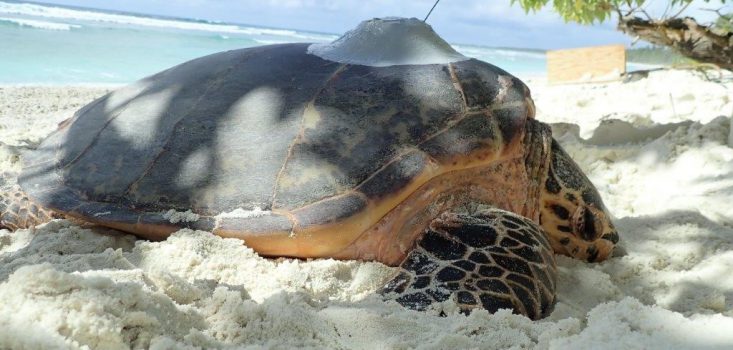As part of the Bertarelli Foundation’s marine science programme, we have funded a long-term study of sea turtles in the British Indian Ocean Territory with the aim of learning more about the biology of the incredible animals and to determine how effective the MPA is at protecting them.
In the midst of the researcher’s expedition to Diego Garcia, British Indian Ocean Territory (BIOT), Dr Nicole Esteban provides an update on her work:
The second sea turtle expedition to Diego Garcia in 2018 is underway. Earlier this year we focused on nesting green turtles and this time we are in BIOT during peak hawksbill nesting season to find out more about this critically endangered species. One of our key conservation research objectives is to increase our understanding of hawksbill turtle nesting in BIOT and their post-nesting movements within and outside of the Marine Protected Area.
Unusually for turtles, hawksbills nest during the daytime in the Western Indian Ocean and often emerge to lay their egg clutches during the incoming tide. So we targeted beach patrols for nesting turtles in line with the daytime incoming tide, either starting patrols early afternoon or before dawn. To maximise our chances of finding turtles, we patrolled a 2.8 km beach in the southeast of Diego Garcia as this stretch of beach has one of the highest turtle track densities on the island and is easily accessible. Hawksbill nesting can be completed fairly quickly and they can return to sea just 45 minutes after emerging so we divided into two groups that patrolled 1.5 km of beach every 40 minutes to ensure we saw any hawksbill that emerged to nest. We were lucky to have assistance from over 50 volunteers to patrol the beach, move the restraining boxes and help with satellite tag attachment.
We were amazed to encounter five nesting turtles on our first day of patrols (four hawksbills and one green turtle). All the hawksbill turtles were measured, flipper tagged and a biopsy taken for DNA analysis. During subsequent days, we saw six more hawksbills. The nesting hawksbill turtles were fairly small and ranged in size from 74-86 cm (curved carapace length).
We attached satellite tags to five of the nesting hawksbills. The satellite tag attachment takes around 2 hours: first the carapace is cleaned, sanded and then cleaned with acetone (nail varnish remover), then the satellite tag is embedded in epoxy paint and lastly painted with a coat of antifoul paint before being left to dry. The satellite tag process is the same as we have used for green turtles (see how we have attached satellite tags on green turtles; https://tinyurl.com/yccp7aur). We keep the turtle cool with shade and by pouring water on the carapace, head and shoulders.
By the end of the expedition, we will have completed two weeks of nesting activity surveys to find out more about nesting emergence timings and the size of the nesting population in Diego Garcia. This will help inform timings for our expedition in November 2019 when we will continue our work with nesting hawksbill turtles. Satellite location uplinks are showing that all the satellite tagged hawksbills are still just offshore of the nesting beach, so we expect they will continue nesting every 12-14 days. In this way we will learn more about how many nests they lay in a breeding season before returning to their foraging grounds.
We wait with baited breath to see the migration destinations of these hawksbill turtles. If you’re interested to receive updates, please join our ‘Chagos Turtles’ Facebook Group .
This research was kindly funded by the Bertarelli Foundation as part of the Bertarelli Programme in Marine Science.




